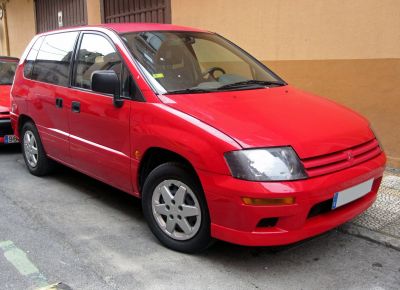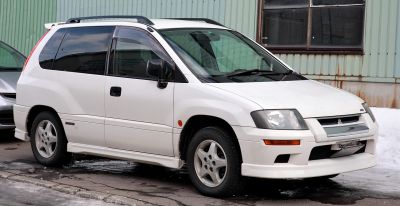 1991 Mitsubishi Space Runner (N1_W,N2_W) Dimensions, Size & Specs
1991 Mitsubishi Space Runner (N1_W,N2_W) Dimensions, Size & SpecsMeasurements of the 1991 Mitsubishi Space Runner, engineered for optimal performance and comfort
| Dimensions | |
|---|---|
| Length: | 4270-4290 mm168.1-168.9 in14.0-14.1 ft |
| Width: | 1695 mm66.7 in5.6 ft |
| Height: | 1640-1680 mm64.6-66.1 in5.4-5.5 ft |
| Trunk Capacity: | 676 liter23.9 cu ft |
| Trunk Capacity (Max): | 1498 liter52.9 cu ft |
| Weight Specifications | |
| Curb Weight: | 1210-1315 kg2668-2899 lbs |
| Maximal permitted Weight: | 1720-1800 kg3792-3968 lbs |
| Tire Specifications | |
| Rims Size: |
|
| Tire Size: |
|
The Mitsubishi Space Runner, produced from 1991 to 1999, is a versatile minivan designed to meet the needs of families and small groups seeking a compact yet spacious vehicle. As part of the N1_W and N2_W generation, this minivan features exterior dimensions ranging from 4270 to 4290 millimeters (168.1 to 168.9 inches) in length, a fixed width of 1695 millimeters (66.7 inches), and a height variable between 1640 and 1680 millimeters (64.6 to 66.1 inches). These dimensions provide a balanced profile that offers maneuverability in urban environments while maintaining ample interior space.
The curb weight of the Space Runner varies between 1210 and 1315 kilograms (2667 to 2899 pounds), with a maximum weight capacity spanning 1720 to 1800 kilograms (3794 to 3968 pounds), making it capable of comfortably handling passengers and cargo. Notably, the minivan boasts a generous luggage capacity of 676 liters (23.9 cubic feet) with all seats in place, which expands significantly to 1498 liters (52.9 cubic feet) when the rear seats are folded down, making it well-suited for transporting larger loads or long-distance travel.
Equipped with 14-inch rims and fitted with 185/70 R14 tires, the Space Runner offers a stable and comfortable ride. Its compact yet spacious design, combined with practical features and sufficient cargo storage, positioned the Space Runner as a competitive choice in the minivan segment throughout the 1990s. Whether for daily commuting or weekend family outings, the Mitsubishi Space Runner delivers a reliable and spacious solution for those prioritizing size and functionality in a mid-sized van.
Discover the standout features that make the 1991 Mitsubishi Space Runner a leader in its class
Have a question? Please check our knowledgebase first.
The Mitsubishi Space Runner (N1_W, N2_W) minivan, produced between 1991 and 1999, features a length ranging from 4270 mm to 4290 mm (approximately 168.1 to 169 inches). Its width is fixed at 1695 mm (about 66.7 inches), while the height varies between 1640 mm and 1680 mm (around 64.6 to 66.1 inches). These compact dimensions make it a practical minivan option, well-suited for urban and suburban driving, providing a balance of interior space and manageable exterior size.
The Mitsubishi Space Runner from 1991 to 1999 has a curb weight ranging from 1210 kg to 1315 kg (approximately 2667 to 2898 pounds). This moderate weight for a minivan provides a solid yet nimble driving experience, contributing to its stability on the road without compromising fuel efficiency drastically. The weight allows the vehicle to maintain decent maneuverability while ensuring a comfortable ride quality. It also positively impacts fuel consumption, balancing power needs with fuel economy for daily commuting and family use.
The Mitsubishi Space Runner measures 1695 mm (66.7 inches) in width. This width is fairly standard for compact minivans, allowing enough interior room for passengers and cargo without making the vehicle too bulky for city streets and parking. The width benefits cabin comfort by providing reasonable shoulder room for occupants. In terms of driving, the moderate width enhances maneuverability, allowing it to navigate narrow roads and tight parking spaces with relative ease, which is an important consideration for everyday use.
Yes, the Mitsubishi Space Runner can generally fit comfortably in a standard garage. With its length between 4270 mm and 4290 mm (168.1 to 169 inches) and width at 1695 mm (66.7 inches), it is compact enough to fit within the typical residential garage dimensions, which usually range from about 4800 mm (width) by 5400 mm (length). The height, varying from 1640 mm to 1680 mm (64.6 to 66.1 inches), should not pose any clearance issues in standard garage door heights. Thus, it fits well for homeowners with typical garage sizes.
The Mitsubishi Space Runner offers a luggage capacity of 676 liters (approximately 23.9 cubic feet) with the rear seats in place, providing practical space for everyday luggage needs such as groceries, sports equipment, or a weekend's worth of travel bags. When the rear seats are folded down, the cargo volume significantly increases to 1498 liters (about 52.9 cubic feet). This expanded space allows for transporting larger items, making the minivan highly versatile for families or anyone needing ample cargo room for bulky items, furniture, or outdoor gear.
The Mitsubishi Space Runner is equipped with 14-inch rims paired with tires sized at 185/70 R14. This tire and rim combination is typical for minivans of the era, providing a good balance between comfort and handling. The 185 mm width offers sufficient grip and traction on various road surfaces, while the 70 aspect ratio (height of the sidewall) helps absorb bumps and road imperfections, contributing to a smooth and comfortable ride. Additionally, the 14-inch rim size maintains moderate unsprung weight, benefiting overall ride dynamics and fuel efficiency.
The height of the Mitsubishi Space Runner ranges from 1640 mm to 1680 mm (64.6 to 66.1 inches), which is characteristic of compact minivans designed for family and utility use. This height provides ample headroom inside the cabin, ensuring passenger comfort, especially for taller occupants. From a practicality point of view, it enables easier ingress and egress, and helps accommodate various seating configurations. Aerodynamically, while taller than a sedan, the vehicle balances its boxy shape for interior space with reasonable drag, keeping fuel consumption and driving stability at efficient levels.
The Mitsubishi Space Runner (N1_W, N2_W) introduced in 1991 did not have a direct predecessor under the same model name as it was one of Mitsubishi's early entries into the compact minivan segment. However, compared to other Mitsubishi vehicles of the preceding years, the Space Runner filled a niche offering a compact yet spacious minivan suitable for families. Its exterior dimensions, like the length of about 4270-4290 mm and width of 1695 mm, made it slightly more maneuverable and efficient than larger vans Mitsubishi had previously offered, offering improved utility without increasing overall vehicle bulk.
When compared with similar compact minivans from the 1990s, the Mitsubishi Space Runner holds its own with competitive dimensions and cargo capacity. Its length (4270-4290 mm / 168.1-169 inches) and width (1695 mm / 66.7 inches) are on par with vehicles like the Toyota LiteAce or Nissan Prairie, which were aimed at urban families needing efficient space usage. Cargo capacity of 676 liters (23.9 cubic feet) expands impressively to 1498 liters (52.9 cubic feet) with folded rear seats, offering versatile storage comparable to rivals. Overall, it balances city-friendly compactness with ample interior room effectively.
The Mitsubishi Space Runner has a maximum weight capacity between 1720 kg and 1800 kg (about 3792 to 3968 pounds), which includes the vehicle's curb weight plus passengers and cargo. This capacity allows for a reasonable combination of passengers (commonly up to 7 in minivan configurations) and cargo without risking vehicle overloading. Staying within this maximum weight ensures safety, optimal handling, and braking performance. It also helps preserve the vehicle’s mechanical integrity and extends its lifespan, making the Space Runner reliable for family use and moderate hauling.
Discover similar sized cars.

| Production: | 1999-2002 |
|---|---|
| Model Year: | 1999 |
| Length: | 4290 mm168.9 in |
| Width: | 1695 mm66.7 in |
| Height: | 1650 mm65.0 in |

| Production: | 1997-2002 |
|---|---|
| Model Year: | 1997 |
| Length: | 4280-4300 mm168.5-169.3 in |
| Width: | 1695 mm66.7 in |
| Height: | 1650 mm65.0 in |
